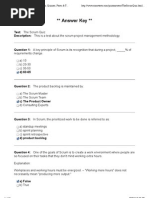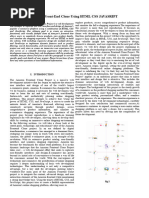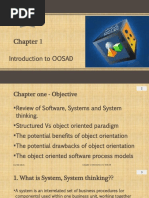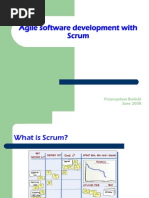Object Oriented Programming
Object Oriented Programming
Uploaded by
Nikhil BharadwajCopyright:
Available Formats
Object Oriented Programming
Object Oriented Programming
Uploaded by
Nikhil BharadwajOriginal Title
Copyright
Available Formats
Share this document
Did you find this document useful?
Is this content inappropriate?
Copyright:
Available Formats
Object Oriented Programming
Object Oriented Programming
Uploaded by
Nikhil BharadwajCopyright:
Available Formats
Object Oriented Programming: Object oriented programming is an approach that
provides a way of modularizing programs by creating partitioned memory area for both data
and functions that can be used as templates for creating copies of such modules on demand.
OOP treats data as a critical element in the program development and does not allow it to flow
freely around the system. It ties data more closely to the functions that operate on it, and protect
it from accidental modification from outside functions. OOP allows decomposition of a
problem into a number of entities called objects and then builds data and functions around these
objects. The data of an object can be accessed only by the functions associated with that object.
However, functions of one object can access the functions of other objects.
Some of the striking features of object- oriented programming are:
o Emphasis is on data rather than procedure
o Programs are divided into what are known as objects.
o Data structures are designed such that they characterize the objects.
o Functions that operate on the data of an object are tied together in the data structure.
o Data is hidden and cannot be accessed by external functions.
o Objects may communicate with each other through functions.
o New data and functions can be easily added whenever necessary.
o Follows bottom-up approach in program design.
Basic Concept of Object oriented Programming: Objects, Classes, Data
abstraction and encapsulation, Inheritance, Polymorphism, Dynamic binding, Message passing
Benefits of OOP:
o Through inheritance, we can eliminate redundant code and extend the use of existing classes.
o We can build programs from the standard working modules that communicate with one
another. This leads to saving of development time and higher productivity.
o The principal of data hiding helps the programmer to build secure programs that cannot be
invaded by code in other parts of the program.
o It is possible to have multiple instances of an object to co-exist without any interference.
o It is possible to map objects in the problem domain to those in the program.
o It is easy to partition the work in a project based on objects.
o The data-centered design approach enables us to capture more details of a model in
implementable form.
o Object oriented systems can be easily upgraded from small to large systems.
o Message passing techniques for communication between objects makes the interface
descriptions with external systems much simpler.
o Software complexity can be easily managed.
You might also like
- The Subtle Art of Not Giving a F*ck: A Counterintuitive Approach to Living a Good LifeFrom EverandThe Subtle Art of Not Giving a F*ck: A Counterintuitive Approach to Living a Good LifeRating: 4 out of 5 stars4/5 (6026)
- The Gifts of Imperfection: Let Go of Who You Think You're Supposed to Be and Embrace Who You AreFrom EverandThe Gifts of Imperfection: Let Go of Who You Think You're Supposed to Be and Embrace Who You AreRating: 4 out of 5 stars4/5 (1133)
- Never Split the Difference: Negotiating As If Your Life Depended On ItFrom EverandNever Split the Difference: Negotiating As If Your Life Depended On ItRating: 4.5 out of 5 stars4.5/5 (911)
- Grit: The Power of Passion and PerseveranceFrom EverandGrit: The Power of Passion and PerseveranceRating: 4 out of 5 stars4/5 (628)
- Hidden Figures: The American Dream and the Untold Story of the Black Women Mathematicians Who Helped Win the Space RaceFrom EverandHidden Figures: The American Dream and the Untold Story of the Black Women Mathematicians Who Helped Win the Space RaceRating: 4 out of 5 stars4/5 (938)
- Shoe Dog: A Memoir by the Creator of NikeFrom EverandShoe Dog: A Memoir by the Creator of NikeRating: 4.5 out of 5 stars4.5/5 (548)
- The Hard Thing About Hard Things: Building a Business When There Are No Easy AnswersFrom EverandThe Hard Thing About Hard Things: Building a Business When There Are No Easy AnswersRating: 4.5 out of 5 stars4.5/5 (359)
- Her Body and Other Parties: StoriesFrom EverandHer Body and Other Parties: StoriesRating: 4 out of 5 stars4/5 (831)
- Elon Musk: Tesla, SpaceX, and the Quest for a Fantastic FutureFrom EverandElon Musk: Tesla, SpaceX, and the Quest for a Fantastic FutureRating: 4.5 out of 5 stars4.5/5 (481)
- The Emperor of All Maladies: A Biography of CancerFrom EverandThe Emperor of All Maladies: A Biography of CancerRating: 4.5 out of 5 stars4.5/5 (275)
- The Yellow House: A Memoir (2019 National Book Award Winner)From EverandThe Yellow House: A Memoir (2019 National Book Award Winner)Rating: 4 out of 5 stars4/5 (99)
- The Little Book of Hygge: Danish Secrets to Happy LivingFrom EverandThe Little Book of Hygge: Danish Secrets to Happy LivingRating: 3.5 out of 5 stars3.5/5 (434)
- Devil in the Grove: Thurgood Marshall, the Groveland Boys, and the Dawn of a New AmericaFrom EverandDevil in the Grove: Thurgood Marshall, the Groveland Boys, and the Dawn of a New AmericaRating: 4.5 out of 5 stars4.5/5 (273)
- The World Is Flat 3.0: A Brief History of the Twenty-first CenturyFrom EverandThe World Is Flat 3.0: A Brief History of the Twenty-first CenturyRating: 3.5 out of 5 stars3.5/5 (2283)
- The Sympathizer: A Novel (Pulitzer Prize for Fiction)From EverandThe Sympathizer: A Novel (Pulitzer Prize for Fiction)Rating: 4.5 out of 5 stars4.5/5 (125)
- A Heartbreaking Work Of Staggering Genius: A Memoir Based on a True StoryFrom EverandA Heartbreaking Work Of Staggering Genius: A Memoir Based on a True StoryRating: 3.5 out of 5 stars3.5/5 (233)
- Team of Rivals: The Political Genius of Abraham LincolnFrom EverandTeam of Rivals: The Political Genius of Abraham LincolnRating: 4.5 out of 5 stars4.5/5 (235)
- Boomi Azure Devops and CICD Process AutomationDocument5 pagesBoomi Azure Devops and CICD Process AutomationmohanNo ratings yet
- On Fire: The (Burning) Case for a Green New DealFrom EverandOn Fire: The (Burning) Case for a Green New DealRating: 4 out of 5 stars4/5 (75)
- UI5 TrainingDocument118 pagesUI5 TrainingvenubhaskarNo ratings yet
- The Unwinding: An Inner History of the New AmericaFrom EverandThe Unwinding: An Inner History of the New AmericaRating: 4 out of 5 stars4/5 (45)
- The Scrum Quiz - SomeTests - Com - Tests, Quizzes, Facts & TriviaDocument3 pagesThe Scrum Quiz - SomeTests - Com - Tests, Quizzes, Facts & TriviaRodrigo Vallejo63% (8)
- Agile For EverybodyDocument65 pagesAgile For Everybodyafreeman.recycleNo ratings yet
- Amazon Front-End Clone Using HTML CSS JAVASRIPTDocument6 pagesAmazon Front-End Clone Using HTML CSS JAVASRIPTShivam Kumar MishraNo ratings yet
- SOFTWARE ENGINEERING March 2021Document4 pagesSOFTWARE ENGINEERING March 2021Anju KolaNo ratings yet
- OOP's MaheshDocument14 pagesOOP's MaheshraghavanmelkundiNo ratings yet
- Bug Tracking System Java ProjectDocument10 pagesBug Tracking System Java Projectranjeet kadamNo ratings yet
- Introduction To PythonDocument6 pagesIntroduction To PythonKrishnaprasad kNo ratings yet
- Ultimate DevSecOps Library 1706607714Document27 pagesUltimate DevSecOps Library 1706607714phenhomenal ecommerceNo ratings yet
- Python Web FrameworkDocument5 pagesPython Web FrameworkAdli AzriNo ratings yet
- Boom Joshi ResumeDocument4 pagesBoom Joshi ResumeAmar BhapkarNo ratings yet
- ISTQB-Foundation-Agile-Syllabus - Chapter 2Document25 pagesISTQB-Foundation-Agile-Syllabus - Chapter 2Mostafa AbdelmageedNo ratings yet
- COSC102 HW1-version1-1Document4 pagesCOSC102 HW1-version1-1malakalsaleh05No ratings yet
- Introduction To OOSADDocument103 pagesIntroduction To OOSADtaye teferaNo ratings yet
- Menifesto of Agile Software DevelopmentDocument5 pagesMenifesto of Agile Software DevelopmentMohammad FawadNo ratings yet
- Banking Management SystemDocument21 pagesBanking Management SystemAnikait SharmaNo ratings yet
- TMS Component License AgreementDocument2 pagesTMS Component License AgreementRaga SilinapasNo ratings yet
- Lecture # 13 - Software Test AutomationDocument29 pagesLecture # 13 - Software Test Automationaffanabbasi015No ratings yet
- Devops - Unit 2Document25 pagesDevops - Unit 2shashi.citrix03No ratings yet
- About Testing: Test Management Tool, by Using JamaDocument5 pagesAbout Testing: Test Management Tool, by Using JamaPv PravallikaNo ratings yet
- Using EHLLAPI in C# - CodeProjectDocument6 pagesUsing EHLLAPI in C# - CodeProjectAngel SaezNo ratings yet
- Pmi AcpDocument33 pagesPmi AcptobyhungwcNo ratings yet
- Week 13 Activity PDFDocument13 pagesWeek 13 Activity PDFkashinath.kbNo ratings yet
- DanielMonterde Resume Jan2023Document4 pagesDanielMonterde Resume Jan2023Daniel MonterdeNo ratings yet
- Advanced Software Engineering - 01Document18 pagesAdvanced Software Engineering - 01Như NguyễnNo ratings yet
- Azure DevOps WorkflowDocument5 pagesAzure DevOps Workflowqtzom2385No ratings yet
- Agile Software Development With ScrumDocument25 pagesAgile Software Development With Scrumssleandro100% (1)
- How To Use Google Maps With Vue - Js Apps - Better Programming - MediumDocument26 pagesHow To Use Google Maps With Vue - Js Apps - Better Programming - MediumBassirou LoNo ratings yet
- Introduction To The Class Builder in SAP S4HANADocument8 pagesIntroduction To The Class Builder in SAP S4HANAabdul.shaikNo ratings yet






































































